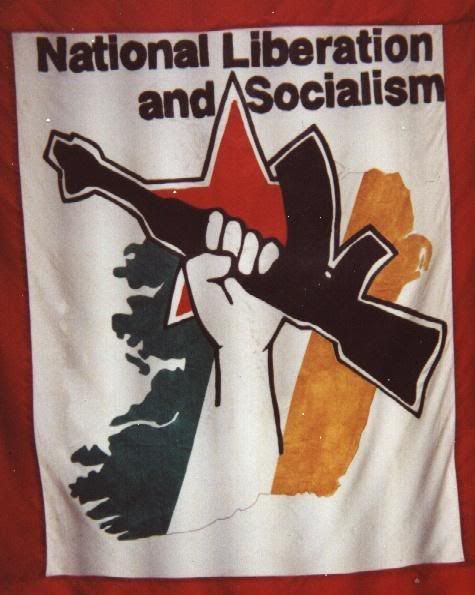First World War and its effect on rights
The advent of the First World War and its immediate aftermath had an impact on several areas concerning 'rights'. This impact was particularly noticeable in relation to Ireland; the extension of votes for men and the inclusion of women in the general franchise.
Struggle for Ireland
The Irish Home Rule bill (proposing an independent Ireland) had been postponed upon the outbreak of war. This was the background to the Easter Rising in 1916. Members of nationalist organisations the Irish Volunteers and the Citizens' Army took control of key public buildings in Dublin. The Citizens' Army was led by James Connolly, a radical trade unionist who had founded the Irish Socialist Party in 1896. Another of the rebellion leaders, Patrick Pearse, read a declaration of independence on behalf of 'the Provisional Government of the Irish Republic' at the General Post Office. The rebellion was defeated after a week of fierce fighting and 15 of its leaders were executed.
At the end of the war the Home Rule Bill was passed. Fighting broke out in 1919, and by 1920-21 the country was engaged in a vicious, bitter and brutal undercover war between Irish nationalists and the British Army. After a long guerrilla campaign against the British Army, Ireland was granted partial home rule. This resulted in two Home Rule acts: one for the six counties of Northern Ireland and a second forming the Irish Free State of the 26 southern counties. Michael Collins, who had signed the Treaty for the Irish Free State, was assassinated during the civil war between the Free State forces under his control and the Irish Republican Army that refused to accept the partition of Ireland.
Not until 1949, with the repeal of the External Relations Act, would Ireland leave the Commonwealth as the Republic of Ireland.

Extension of the vote for men
One of the popular promises that came with the close of the First World War in 1918 was 'homes fit for heroes'. This began to symbolise much more than 'a home', and was taken to include the right to a better and secure standard of living. However the post-war boom was short. By the early 1920s unemployment and economic problems were holding back the ideal. Politically this set the scene for the first (minority) Labour Government in 1924 and the run up to the General Strike in 1926.
Strikes had been illegal during the war and a number of socialist activists were imprisoned. Trade unionism revived in 1919, but the defeat of the General Strike in May 1926 saw a downturn in trade union activity. Miners however held out until October when the hardships and poverty forced men back to the mines. Many claimed to have been victimiszed and remained unemployed for years. Those in employment had to accept longer hours and lower wages.
Unemployment
Unemployment remained at or above 1.25 million throughout the 1920s. The economic downturn prompted by the Wall Street crash in 1929, increased this from 1.5 million to 2.9 million between 1930 and 1935. Mass unemployment seriously undermined not only Labour Party aspirations, but also the trade union movement's ability to secure a greater standard of living. The post-war period was punctuated by a series of hunger marches designed to draw attention to the plight of the poor and unemployed. Some of these were led by the communist-run National Unemployed Workers' Movement. The most well known of the marches was the 'Jarrow Crusade' of 1936 when 200 unemployed men marched from Jarrow to London.
Enfranchisement of women
The achievement of the parliamentary franchise for women came in stages. The 1918 Representation of the People Act granted the vote to all men over 21 (in order to overcome the residence requirements which the vote still placed on men who had served abroad) and to women over 30, who were graduates or who met, or whose husbands met, certain property requirements. However it was not until the 1928 Equal Franchise Act that women were finally granted the right to vote on the same footing as men.
View this extract from the Deputation from the Equal Political Rights Campaign Committee to discuss the enfranchisement of women in 1927.

'From cradle to grave'
In today's society, much have changed, as expected than it was back then. For example, all women have the right to vote. Women have come very far in terms of equal rights. Women still do not receive equal pay for same work, but I think one day we will get there. Women take a more active role in the workplace in providing for the family as well. Many homes are single parent home, run by women.
The last sixty plus years have seen the numbers of women in the workplace increase hugely since they entered the economic system to supplement the male earning capacity lost to two world wars.
Complex social movements have contributed to this change, the feminist movement, equal opportunities legislation, the expansion of the service sector and the knowledge economy, the ever increasing cost of living and increased access to ecucation.
The rise in numbers has resulted in women entering a much broader range of occupations, from mainly supportive, nurturing roles such as teaching and nursing to every walk of occupational and professional life.
Therefore, women are now found in occuations, industries and roles previously regarded as the sole prerogative of men
No comments:
Post a Comment